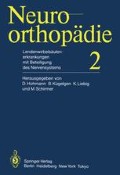Zusammenfassung
Eine Enge des lumbalen Spinalkanals — die schätzungsweis bei ca. 5% der Bevölkerung vorkommt (Eisenstein, 1977) — kann für den Betroffenen ohne Bedeutung sein. Unter bestimmten Bedingungen führt diese Enge jedoch zu einer Irritation, in schweren Fällen zu einer tiefergreifenden Schädigung der Cauda equina.
Access this chapter
Tax calculation will be finalised at checkout
Purchases are for personal use only
Preview
Unable to display preview. Download preview PDF.
Literatur
Benini A (1976) Ischias ohne Bandscheibenvorfall: Die Stenose des lumbalen Wirbelkanals und ihre klinisch-chirurgische Bedeutung. Hans Huber, Bern Stuttgart Wien
Breig A (1960) Biomechanics of the central nervous system. Almquist & Wiksell, Stockholm
Eisenstein E (1977) The morphometry and pathological anatomy of the lumbar spine in South African negroes and Caucasoids with specific reference to spinal stenosis. J Bone Joint Surg 59B: 173–180
Gilfillan RS, Jones jr OW, Roland SI, Wylie EJ (1954) Arterial occlusions simulating neurological disorders of the lower limbs. J Am Med Assoc 154: 1149–1152
Grundfest H (1936) Effects of hydrostatic pressure upon the excitability, the recovery and the potential sequence of frog nerve. Cold Spring Harbor Symp Quant Biol 4: 179–187, zit n. Ochoa 1972
Ochoa J, Fowler TJ, Gilliat RW (1972) Anatomical changes in peripheral nerves compressed by a pneumatic tourniquet. J Anat 113: 433–455
Rau H, Esslen E (1973) Die neurogene Claudicatio intermittens. Dtsch Med Wochenschr 98: 2057–2060
van Gelderen Chr (1948) Ein orthotisches (lordotisches) Kaudasyndrom. Aeta Psychiatr Neurol 23: 57–68
Verbiest H (1976) Neurogenic intermittent claudication. In: Vinken PJ, Bruyn GW (eds) Handbook of Clinical Neurology, Vol 20 pp 611–807 North-Holland publishing company, Amsterdam
Verbiest H (1980) Stenosis of the lumbar vertebral canal and sciatica. Neurosurg Rev 3: 75–89
Editor information
Editors and Affiliations
Rights and permissions
Copyright information
© 1984 Springer-Verlag Berlin · Heidelberg
About this chapter
Cite this chapter
Vogel, P. (1984). Klinik des engen Spinalkanals. In: Hohmann, D., Kügelgen, B., Liebig, K., Schirmer, M. (eds) Lendenwirbelsäulenerkrankungen mit Beteiligung des Nervensystems. Neuroorthopädie, vol 2. Springer, Berlin, Heidelberg. https://doi.org/10.1007/978-3-642-68974-1_23
Download citation
DOI: https://doi.org/10.1007/978-3-642-68974-1_23
Publisher Name: Springer, Berlin, Heidelberg
Print ISBN: 978-3-642-68975-8
Online ISBN: 978-3-642-68974-1
eBook Packages: Springer Book Archive

